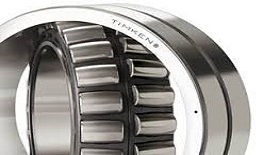The installation of aligning roller bearing
The aligning roller bearing is equipped with a roller bearing. The curvature center of the outer ring raceway surface is consistent with the bearing center, so it has the same central function as the automatic aligning ball bearing. When deflection of shaft and shell occurs, the axial load can be adjusted automatically in two directions. The radial load capacity is large, which is suitable for heavy load and impact load. The inner diameter of the inner ring is the bearing of the taper hole, which can be directly installed or use the tightener sleeve and disassembly cylinder to install on the cylinder shaft. The cage is made of sheet metal stamping, polyamide and copper alloy car.
For self-aligning bearings, the use of an intermediate mounting ring prevents the outer ring from tilting and rotating when the bearing with a shaft is loaded into the housing bore. It should be remembered that some sizes of self-aligning ball bearings protrude from the side of the bearing, so intermediate mounting rings should be recessed to prevent damage to the ball bearings. A large number of bearings are generally installed by mechanical or hydraulic press.
For separable bearings, the inner ring and the outer ring can be installed separately, which simplifies the installation process, especially when the inner and outer rings need to work together. When loading the shafts with the inner ring installed into the bearing box with the outer ring, it is necessary to check whether the inner and outer rings are correctly aligned to avoid scratching the bearing raceway and rolling parts. Mounting sleeves are recommended if cylindrical and needle bearings use an inner ring without flange flange flange or an inner ring with flange flange on one side. The outer diameter of the sleeve should be equal to the diameter F of the inner ring raceway, and the tolerance standard for machining should be d10. It is best to use the mandrel mounting for stamping outer ring needle bearing.



